|
TennisOne Lessons
Martina Hingis' Volley: Simplicity and ControlAdvertising Space Jim McLennan, Senior Editor, TennisONE (Hingis photos by Steve
Lacey.) To see Part 1 (Overall Style) in Hingis series: To see Part 2 (Forehand) in Hingis series:
As I've discussed in my two previous articles, one of Martina Hingis' great strengths is her all-court game. Unlike so many women players (even great ones like Graf), when she has an opportunity to come to the net, she takes it--and usually wins the point with a single volley. Remember her championship point at the recent US Open: wide serve to the deuce court and a sharply angled and underspun backhand volley totally out of reach of a racing Venus Williams. Now to the nuts and bolts of Hingis' all-around net play. And note, just like McEnroe, she constantly plays doubles, preferring it to practice (just like Mac). She has even said that she thinks of herself as a player (as opposed, I assume, to a hitter or practicer). The volley should be a stroke not a punch. The racquet moves from high to low, the racquet frame remains angled so the lower edge leads throughout the stroke, and the shot is always hit with backspin.
Stroke don't punch: The difference is easily seen in the preparation. Punchers are compact, the racquet arm held tightly against the body. Strokers hold the elbow well away from the ribs, the racquet and hitting arm create a longer lever, the preparation element appears big not little. (But, the strings must always face the ball at this point of the backswing).
Click here to see an animation from a recent TennisONE lesson on volleys, showing the principles in this article.
Send email to the author We encourage you to email your comments (pro, con, appreciative, whatever)
directly to the author. To send email to Jim McLennan, click
here.
|
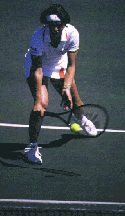
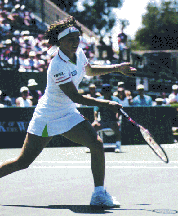 The
photographs show both the forehand and backhand volley, the racquet finishing
well in front and obviously low, and the lower edge definitely leading.
In each instance the finish clearly identifies both the length of the stroke
(not punch) and the pronounced backspin.
The
photographs show both the forehand and backhand volley, the racquet finishing
well in front and obviously low, and the lower edge definitely leading.
In each instance the finish clearly identifies both the length of the stroke
(not punch) and the pronounced backspin.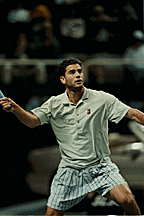
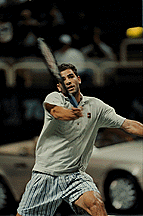
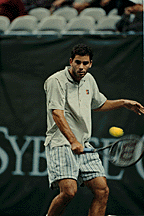
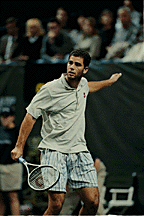 Lead
with the lower edge - because of the initial high racquet head position,
and because of the stroking down and through the ball, the racquet face
must be angled. Pete and Martina are both sublime, in that they both retain
the same angle/edge throughout the entire stroke. Rather than "turning
the key," which describes a use of the wrist that dishes under the
ball at impact and is just as tricky as it sounds, they gain firmness and
control from simplicity and leverage.
Lead
with the lower edge - because of the initial high racquet head position,
and because of the stroking down and through the ball, the racquet face
must be angled. Pete and Martina are both sublime, in that they both retain
the same angle/edge throughout the entire stroke. Rather than "turning
the key," which describes a use of the wrist that dishes under the
ball at impact and is just as tricky as it sounds, they gain firmness and
control from simplicity and leverage.